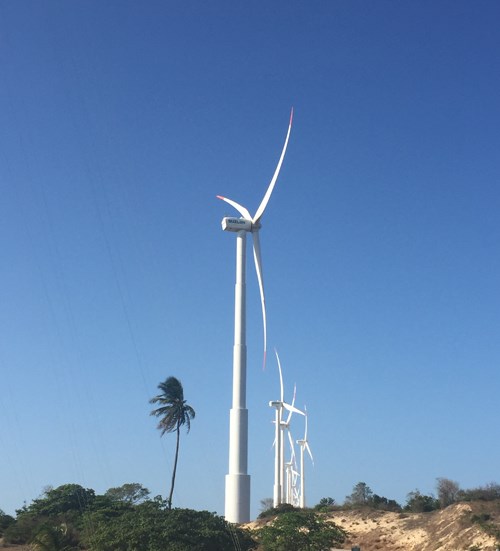In Brazil, where the wind blows and blows
CW editor Jeff Sloan is in northeastern Brazil this week, getting an up-close look at the Brazilian wind market, and a dynamic manufacturer of wind blades.

Shorline wind farm, near Port of Pecém in the Brazilian state of Ceará.
I am in Brazil this week, visiting a wind blade manufacturer, near Fortaleza in the state of Ceará, in the northeast of the country. This region is, for Brazil, where the wind blows at its best, and it has become the de facto home of many of the country's wind farms and some of the country's wind blade manufacturers. We don't talk much about wind energy opportunities in Brazil, but they are substantial for many reasons.
First, the profile of electricity generation in Brazil is unlike that of other major countries. Brazil is the second largest producer of hydroelectric power in the world (behind China), and the country relies on hydroelectricity for more than 75% of its power. Most of the hydropower, naturally, comes from river systems in the north and northwest part of the country, which is far removed from major population centers and thus presents a challenge from an energy transmission and reliability perspective.

Brazil mean annual wind speed.
An inherent problem of hydropower is that it depends on water, and when there's a drought, water flow is reduced, thus energy generation is reduced. To help fill in the of the energy gaps in hydropower supply, the country is turning to other resources to help stabilize energy supply. These include liquified natural gas, wind and solar power. Wind's advantage stems from the fact that the northeast region, where winds are generally stronger, are strongest during a drought, which makes wind energy complementary to hydropower.
Further, the wind turbine manufacturing supply chain in Brazil is already very mature, which means that infrastructure and manufacturers are in place to meet the needs of wind energy farm development. This is important because Brazil's national state-run bank, National Development Bank (BNDES), which finances much of the country's wind farm development, stipulates that wind turbines erected in Brazil must be manufactured in Brazil. This demand for local content is designed, of course, to drive economic development and job creation, which it has.
Indeed, according to the Global Wind Energy Council (GWEC) Brazil wind energy capacity has increased from just 29 MW in 2005 to 8.7 GW by the end of 2015, ranking it 10th in the world in total installed wind energy capacity. Brazil installed 2.75 GW of wind energy in 2015, and the wind energy sector employs more than 41,000 people.
There is still the issue of energy transmission, given that so much of Brazil's wind farms are remotely located, but the Brazilian government is using an auction system to lure transmission developers into bidding on projects. Response to the auctions, however, has been lukewarm, in part because Brazil's economy and political situation are so tenuous.
Still, the country is committed to wind, and the future seems bright. I'll have a full report on my wind blade plant tour in an upcoming issue of CompositesWorld magazine. Keep your eyes peeled.
Related Content
JEC World 2022, Part 3: Emphasizing emerging markets, thermoplastics and carbon fiber
CW editor-in-chief Jeff Sloan identifies companies exhibiting at JEC World 2022 that are advancing both materials and technologies for the growing AAM, hydrogen, automotive and sustainability markets.
Read MorePlant tour: ÉireComposites, Galway, Ireland
An in-house testing business and R&D focus has led to innovative materials use and projects in a range of markets, from civil aerospace to renewable energy to marine.
Read MoreRecycling end-of-life composite parts: New methods, markets
From infrastructure solutions to consumer products, Polish recycler Anmet and Netherlands-based researchers are developing new methods for repurposing wind turbine blades and other composite parts.
Read MoreNovel dry tape for liquid molded composites
MTorres seeks to enable next-gen aircraft and open new markets for composites with low-cost, high-permeability tapes and versatile, high-speed production lines.
Read MoreRead Next
Composites end markets: Energy (2024)
Composites are used widely in oil/gas, wind and other renewable energy applications. Despite market challenges, growth potential and innovation for composites continue.
Read MoreFrom the CW Archives: The tale of the thermoplastic cryotank
In 2006, guest columnist Bob Hartunian related the story of his efforts two decades prior, while at McDonnell Douglas, to develop a thermoplastic composite crytank for hydrogen storage. He learned a lot of lessons.
Read MoreCW’s 2024 Top Shops survey offers new approach to benchmarking
Respondents that complete the survey by April 30, 2024, have the chance to be recognized as an honoree.
Read More











.jpg;maxWidth=300;quality=90)













